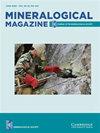俄罗斯Murun碱性络合物中fedorite Na2.5(Ca4.5Na2.5)[Si16O38]F2⋅2.8H2O的高温行为
IF 1.4
3区 地球科学
Q2 MINERALOGY
引用次数: 0
摘要
摘要采用电子探针微分析(EPMA)、差热分析(DTA)、热重(TG)、原位高温单晶x射线衍射(HT-SCXRD)、非原位高温傅里叶变换红外光谱(HT-FTIR)研究了俄罗斯穆伦地块费长石的热行为。研究的fedorite样品的经验化学式为:(Na1.56K0.72Sr0.12)Σ2.40(Ca4.42Na2.54Mn0.02Fe0.01Mg0.01)Σ7.00(Si15.98Al0.02)Σ16.00(F1.92Cl0.09)Σ2.01(O37.93OH0.07)Σ38.00⋅2.8H2O。热重曲线显示,在25 ~ 1050°C的脱水和除氟过程中,总质量下降了~5.5%。Fedorite在空间群P$\bar{1}$中结晶,a = 9.6458(2), b = 9.6521(2), c = 12.6202(4) Å, α = 102.458(2), β = 96.2250(10), γ = 119.9020(10)°,胞体体积V = 961.69(5) Å3。在25-600℃的空气中进行HT-SCXRD。总体而言,尽管c胞尺寸在探测温度范围内略有减小,但观察到单位胞体积的持续膨胀。结构细化表明,从25℃到300℃,该矿物经历了脱水过程,层间大部分H2O损失。高温傅里叶变换红外光谱证实,fedorite在700°C前逐渐脱水。本文章由计算机程序翻译,如有差异,请以英文原文为准。
High-temperature behaviour of fedorite, Na2.5(Ca4.5Na2.5)[Si16O38]F2⋅2.8H2O, from the Murun Alkaline Complex, Russia
Abstract The thermal behaviour of fedorite from the Murun massif, Russia, has been investigated by means of electron probe microanalysis (EPMA), differential thermal analysis (DTA), thermogravimetry (TG), in situ high-temperature single-crystal X-ray diffraction (HT-SCXRD), ex situ high-temperature Fourier-transform infrared spectroscopy (HT-FTIR). The empirical chemical formula of the sample of fedorite studied is: (Na1.56K0.72Sr0.12)Σ2.40(Ca4.42Na2.54Mn0.02Fe0.01Mg0.01)Σ7.00(Si15.98Al0.02)Σ16.00(F1.92Cl0.09)Σ2.01(O37.93OH0.07)Σ38.00⋅2.8H2O. The TG curve provides a total mass decrease of ~5.5%, associated with dehydration and defluorination processes from 25 to 1050°C. Fedorite crystallises in space group P$\bar{1}$ and has: a = 9.6458(2), b = 9.6521(2), c = 12.6202(4) Å, α = 102.458(2), β = 96.2250(10), γ = 119.9020(10)° and cell volume, V = 961.69(5) Å3. The HT-SCXRD was carried out in air in the 25–600°C range. Overall, a continuous expansion of the unit-cell volume was observed although the c cell dimension slightly decreases in the explored temperature range. Structure refinements indicated that the mineral undergoes a dehydration process with the loss of most of the interlayer H2O from 25 to 300°C. The HT-FTIR spectra confirmed that fedorite progressively dehydrates until 700°C.
求助全文
通过发布文献求助,成功后即可免费获取论文全文。
去求助
来源期刊

Mineralogical Magazine
地学-矿物学
CiteScore
4.00
自引率
25.90%
发文量
104
审稿时长
6-12 weeks
期刊介绍:
Mineralogical Magazine is an international journal of mineral sciences which covers the fields of mineralogy, crystallography, geochemistry, petrology, environmental geology and economic geology. The journal has been published continuously since the founding of the Mineralogical Society of Great Britain and Ireland in 1876 and is a leading journal in its field.
 求助内容:
求助内容: 应助结果提醒方式:
应助结果提醒方式:


